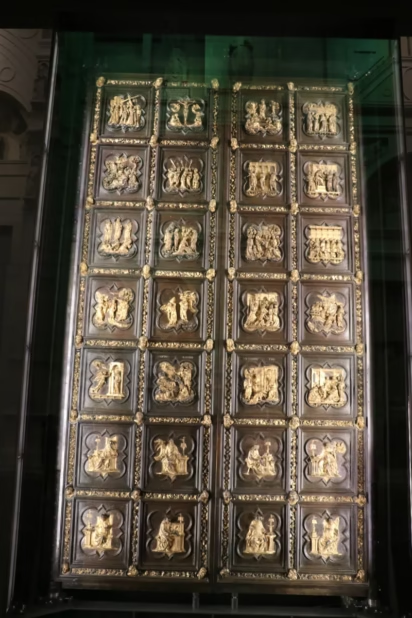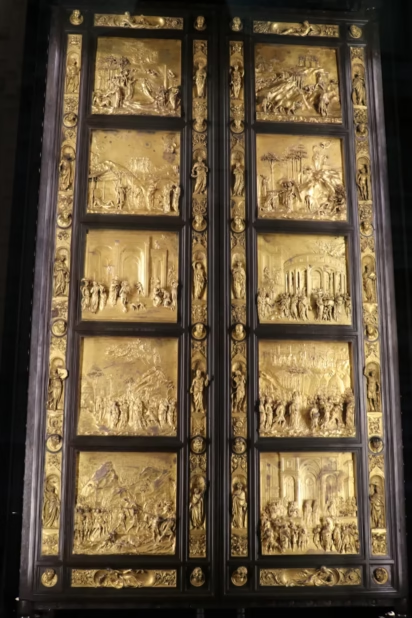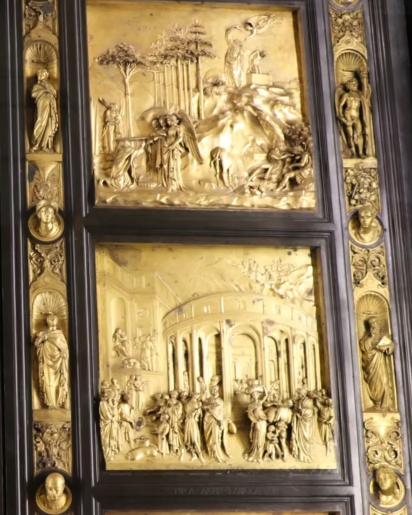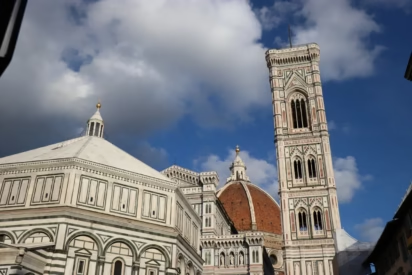The marble-clad baptistry (battistero) in Florence is famous for its magnificent bronze doors. Visit the interior to see the dome mosaics.

The Romanesque battistero to the west of the famous Duomo in Florence was the baptistry for all Florentine newborns for centuries. The white and green marble-clad exterior is particularly famous for the three sets of magnificent bronze doors by Andrea Pisano and Lorenzo Ghiberti, who created the Gates of Paradise. The small interior is mostly bare but the ceiling of the dome is covered in a 13th-century mosaic considered the most significant narrative cycle in Florence predating Giotto. Admission to see the interior of the baptistery is charged — guided tours usually include other sites such as the museum and climbing the cupola of the Duomo.
Ongoing restoration work may hide some of the mosaics from view for much of 2025.
Construction of the Baptistery (Battistero) in Florence
The Baptistery of St John the Baptist (Battistero di San Giovanni a Firenze) immediately to the west of the Duomo is one of the oldest buildings in Florence. It is in a Florentine Romanesque style, sometimes also described as proto renaissance. The baptistery was already completed around a century before the construction of the cathedral started.
The current baptistry in Florence was erected mostly during the late 11th and early 12th centuries. It probably replaced an older baptistry that according to legend was built on the foundations of a Roman temple dedicated to Mars.
Mars & Flora
Mars, the Roman god of war, was the male protector of Florence and symbolized by a lion that is still one of the symbols of the city — the Marzocco. (Donatello’s lion is in the Bargello Museum with a copy in front of the Palazzo Vecchio.)
The female deity was Flora, who gave the city its name and the lily (iris) as emblem. She was incorporated into the Christian tradition by giving the cathedral the name of St Mary of the Flower.
Exact dates from the early history of the baptistery are only known from major events, or when significant payments were necessary for building and decoration work. Pope Nicholas II consecrated the baptistery in 1059 but it is unknown if the current building was already fully in use at that stage.
The baptismal font from Santa Reparata, over which the present Duomo was erected, was moved into the baptistry in 1128 — all Christian children born in Florence were baptized here until the 19th century. The lantern was added around 1150 but that was often enough done only years after the rest of a church was completed. The entrance porch was changed from a half-round to its present rectangular shape in 1202. Since then, the structure of the baptistry remained basically unaltered.
Architecture of the Battistero Baptistery in Florence
The floor plan of the baptistry in Florence is a simple octagon, which was traditional for baptistries, and a small rectangular apsis on the western end. The north, east and south sides have famous sculpted bronze doors.
The structure is sandstone but the building was clad from the beginning with white and green marble — in contrast to the campanile and duomo, no pink is used.
The dome cannot be detected from the exterior. Its lower parts are covered by the external walls of the third story while the top is covered by a flattened pyramidal roof of pure white marble slabs. Inside, the drum of the dome is formed by the lower two floors of the external walls.
On completion, the diameter of the dome was at 25.6 m the largest for any baptistery in Italy. However, the Battistero in Pisa, constructed between 1152 to 1394, now is the largest baptistry in Italy with its dome having a diameter of 34 m and an impressive height of 55 m.
Visitors step down when entering the baptistry. The building didn’t sink through the centuries. The plaza was raised in the 13th century to create a flat surface level with the surrounding streets. Leonardo da Vinci suggested raising the baptistery in one piece with pulleys to counter the sunken look but nothing ever came of that idea.
Bronze Doors of the Baptistry in Florence

The baptistry has three pairs of ceremonial bronze doors — all were originally installed on the east side facing the cathedral but moved to make space as newer, more artistic doors were produced. The doors in use are copies — the originals are now inside the Duomo Museum.
Wikipedia has a good description of the doors and various themes.
Pisano Doors (South)
The oldest doors are now on the south entrance. These Gothic doors (1330) were made by Andrea Pisano, who was also responsible for many of the decorations on the campanile. These doors have 28 rectangular panels with scenes set in a quatrefoil frame.
The top 20 squares represent the life of John the Baptist from the annunciation to his burial. The bottom eight squares are of the heavenly and earthly virtues. The story is chronological from left to right, top-down on the left door, and then similarly on the right door.
Competition Doors (North)
In 1401, an open competition was used to determine the designers for the doors now on the north portal. Many famous artists, including Donatello, Michelozzo, and Uccello presented ideas. However, the designs of two young goldsmiths in their early 20s, Lorenzo Ghiberti and Filippo Brunelleschi, were chosen. They were co-awarded the contract to produce the doors. Brunelleschi declined — he left for a study trip to Rome and gave up fine art for good in favor of architecture. (The authorities would irritate Brunelleschi a few years later again by awarding Ghiberti co-responsibility for the construction of the cupola of the Duomo. The rivalry continues in the naming of the various Duomo admission ticket passes.)
Ghiberti’s doors, now on the northern side, are also divided into 28 rectangles but are nearly a century newer than those of Pisano. It is often seen as one of the earliest Renaissance works despite the prescription that the scenes had to be framed in quatrefoil similar to the older Gothic doors.
In contrast to the Pisano’s doors, the story here, of the life of Christ, is read from the bottom up, starting with the annunciation to Pentecost. The bottom eight squares are of the four apostles and four saints.
The two winning entries from the competition are now on display in the Bargello Museum, the others were lost. Ironically, the theme for the competition — the sacrifice of Isaac — is from the Old Testament and was never destined for use on these doors. This, as well as the relocation from the east to the north of the building, partly explains why many wrongly described the Gates of Paradise as the competition doors.
Gates of Paradise in Florence
The eastern doors are the real artistic highlight. The commission for another set of doors was given in 1425 to Ghiberti without going through a competition. By now Ghiberti was a well-established artist (he was very good at networking too) and he was allowed more artistic freedom. He abandoned the quatrefoil frames and instead of 28 small plates, produced ten large ones.
It took 27 years to complete the new doors — Ghiberti was in demand in many projects, including the dome of the Duomo to the irritation of Brunelleschi — but the result is a highlight of European art. Michelangelo described the doors as suitable for paradise and the name Gates of Paradise stuck.
The ten squares depict events from the Old Testament and are read chronologically left to right, top to bottom.
The themes on the Gates of Paradise doors are:
- Adam and Eve
- Cain and Able
- Noah
- Abraham and Izak
- Esau and Jacob
- Joseph
- Moses
- Joshua
- David
- Solomon and the Queen of Sheba
Each theme includes several stories — in the scene of Joseph seven events are illustrated. However, more significantly is the use of perspective that allowed Ghiberti to use flattened relief, invented and used by Donatello amongst others in the San Lorenzo, to create large group scenes and architectural depth — particularly notable in the architectural details of the two central scenes and the final arrival of the Queen of Sheba.
The frame is richly decorated with foliage, small statues, and busts. The bust at the lower right corner of the Jacob panel is a self-portrait and immediately to its right is his father, Bartolomeo Ghiberti.
Interior of the Battistero in Florence

The interior with its small windows and mosaics is a reminder that this is a Romanesque, sometimes even proto-renaissance, building preceding the Gothic and Renaissance by centuries.
The interior fittings changed throughout the long history with some of the finest works now in the museum. Apart from the mosaics, the most interesting art inside is the tomb for the antipope John XXIII by Donatello and Michelozzo. It was the first such grave monument with a baldachin produced in the Renaissance. Further tombs included two recycled Roman sarcophagi, which received updated lids when reused during the Middle Ages.
The floor is a hotchpotch of geometrical patterns, which looks less planned, as the interior layout changed through the centuries. The imprint of the large octagonal baptismal font at the center is still clearly visible. This font from St Reparata was removed in 1571 by Grand Duke Francesco I de’ Medici. The current small font was installed in 1658 but is probably much older.
Donatello’s woodcarving of Mary Magdalene was in the baptistry until the floods of 1966. Also, the magnificent silver altar and sections of the original baptismal font are now on display inside the museum.
Mosaic Dome of the Baptistry in Florence

Work on the ceiling mosaic in the dome commenced in 1225 and took around a century to complete. A variety of artists were involved including Jacopo Torriti Cimabue. This mosaic is considered the most significant narrative cycle in Florence predating Giotto. Giotto probably assisted with some of the final work too, as he was in charge of the total Duomo building project for the final few years of his life.
The three panels right above the apse illustrate Christ and the Last Judgement — hell with the humans-eating Satan to his left, heaven to his right. The circular Christ medal is 8 m in diameter.
The remaining five panels of the octagon are decorated thematically as horizontal rings. Directly below the lantern is a decorative ring followed by the heavenly choir of angels. The next four rings, excluding the three panels used by the main picture, are read anti-clockwise and from the top down. They illustrate mostly events from Genesis, the life of Joseph, the life of Christ and the Virgin, and finally the life of John the Baptist.
The mosaics in the small gallery (not accessible to visitors) and some of the chapels were added somewhat later but before mosaics fell decidedly out of fashion. At times it was considered to remove the mosaics rather than fund maintenance work but the original work fortunately survived.
Daylight through the lantern lights the interior beautifully and could put a special shine on the mosaics. However, depending on the time of day could also be blinding. A visit after dark, when the queues are shorter anyway, is also an attractive option.
Visitor Information for the Baptistry in Florence
The baptistery is seen on one of the multiple-site passes used by the Duomo tickets — price depending, it includes the museum, bell tower, and climbing the Dome. There are no separate baptistery-only tickets. The interior of the baptistery is often included on guided tours of other sights including the museum and climbing the cupola.
Opening hours may move around a bit but are usually long: daily from as early as 8:15 until 19:30.
The queues for the battistero are usually not long. Visiting at night is a good option as the ceiling is beautifully lit and without the glare of sunlight streaming through the lantern.
→ See 2025: Florence New Opening Hours of Top Sights, Museums, and Churches for the latest information and current opening hours.
More on the Duomo in Florence
- Visit the Cathedral of Florence (Duomo di Firenze)
- Visit the Baptistry (Battistero)
- Climb Giotto’s Campanile
- Climbing the Brunelleschi Campanile
- Museo dell’Opera del Duomo (Museum of the Works of the Cathedral)
- Tickets and Opening Hours for Visiting the Duomo Sights in Florence
- Current Opening Hours for Top Sights in Florence
- Guided Tours of the Duomo Sights
- More Photos on Flickr
More Articles on Florence Sights
The high season in Florence is increasingly long: Easter, May, July, August, and the Christmas holidays are especially busy. November and January to mid-March are the only quiet months, except for the February school holiday week. Plan and book time-slot reservation tickets and tours when available in advance — the Accademia and the Uffizi are again sold out weeks in advance. Top sights are quieter directly at opening time or in the late afternoon.
→→ Opening hours for top sights in 2025 — most sights have long hours but advance time-slot reservations are always sensible.
- Tips on Buying Tickets for the Uffizi Museum
- Tips on Buying Skip-the-Line Tickets for the Accademia (Michelangelo’s David)
- See Michelangelo’s David in the Galleria dell’ Accademia
- Visit the Duomo sights: Cathedral (Duomo), Baptistery (Battistero), Bell Tower (Campanile), Dome (Cupola), Museum (Museo), and Tickets + Opening Hours
- Visit the Bargello Museum of Sculpture (Donatello’s Davids)
- Visit San Marco Museum to see the frescoes and altarpieces painted by Fra Angelico.
- Visit Santa Maria Novella Church and Museum to see medieval and Renaissance Art.
- Visit Santa Croce for Giotto Frescoes and Michelangelo’s Grave
- San Lorenzo complex: Visit the Basilica for Renaissance Art, See the Laurentian Medici Library by Michelangelo, and Visit the Medici Chapels (Michelangelo Statues)
- Visit the Orsanmichele Church and Museum with sculptures.
- Save on Sightseeing in Florence with the Firenze Card (again available but not including transportation or the Duomo sights, or consider the Turbopass Florence City Pass that includes online timeslot reservations for both the Uffizi and Accademia.
- Travel to Pisa to see the Field of Miracles and the Leaning Tower of Pisa.
- Visit the magnificent Romanesque-Gothic cathedral in nearby Siena.
- Save on top Italian designer fashion at The Mall Factory Outlet Stores.
Florence Resources
- The official website of the Firenze Tourist Office is a bit cumbersome but has very useful information. Especially the pdf (alternative link) with the opening hours of all major sights. Unfortunately, it is only available for the current month but it is the second last line on opening hours — the final say is the guard at the door, NOT the ticket window!
- Get Your Guide offers tours of all major sights while Tiqets sells online tickets for many top sights in Florence.
- Book luggage storage online and explore Florence more easily on foot.
- Trainline is good for booking online train tickets in Italy and most of Europe.











